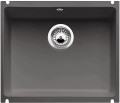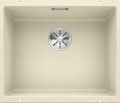—
Stainless steel. The most popular material for modern kitchen sinks. «Stainless Steel» is excellent against corrosion; in addition, it is very durable and reliable, tolerates heating (you can put a hot pan), hygienic (has no pores and does not absorb contaminants) and is relatively inexpensive. The drawbacks include a high level of noise when water falls and a tendency to stains.
—
Artificial stone. Artificial stone is characterized by high strength, while being an absolutely ecological and hygienic material. It does not fade into the sun, has excellent antibacterial properties, is reliable, durable and at the same time smooth and pleasant to the touch. As a rule, the base is
granite,
quartz or
marble crumb with the addition of acrylic resin. Such sinks look attractive and have a smooth surface without pores, because of which they are not inclined to absorb odors. The surface of engineered stone is easy to clean, easy to care for.
— Granite composite. In this case, it is not natural granite, but a composite material based on granite crumb with plastic filler. Such sinks are well absorbed by the noise of falling water, excellent resistance to pollution and easy to clean, in addition have a pleasant appearance and can be performed in the most varied design (under different types and colors of st...one). But poorly tolerated by high temperatures and have a significant weight - in some models up to 50 kg. Similar manufacturing principle and dignity in sinks of marble composite, where only instead of granite chips used marble. A little different from them sinks made of quartz composite (see more. below).
— Ceramic composite. Ceramic sinks are most often made of Sanfayans or Sanfayans. The first material is more affordable, but has a porous structure, because of what tends to absorb not removed in time of contamination, and to remove them is quite difficult; Sanporcelain, in turn, is better to resist pollution, but more expensive. Common features of ceramic materials are, on the one hand, pleasant appearance, on the other - fragility and sensitivity to strong impacts (from such a blow the sink may crack). Also note that the ceramic shells are quite massive, but this moment can be considered as a disadvantage and as a virtue - a large weight reduces the probability of moving the installed product from the place, accidentally hitting.
— Quartz composite. The washing is based on technical quartz produced by sintering quartz sand and binder polymers in a proportion of 80% and 20%. Technical quartz is above all characterised by the highest strength characteristics and is almost completely immune to cracks and chipping. The surface of quartz kitchen sinks has no pores and microfractures, so it does not absorb odors and does not accumulate pathogenic microflora. Additionally, technical quartz exhibits inert properties to cleaning chemicals, vinegar and any other caustic substances. This material does not leave stains from wine and food coloring.
— Copper. Design material found mainly among sinks in the style of «retro» and other unusual design. It has a characteristic yellowish or reddish surface tone, giving the shell an unusual and stylish appearance. In terms of practical properties, this material is similar to stainless steel (see corresponding paragraph. of): in particular, it is durable, reliable and good resistance to corrosion and high temperatures. On the other hand, in the absence of obvious advantages, copper is much more expensive, and therefore it is worth paying attention to this option only if you are looking for a design model with a characteristic appearance.
— Brass. Another designer material similar to the copper described above. It has similar properties and differs only in appearance: the standard color of brass alloy is yellow. However, it is very rarely used for a number of reasons.
—Glass. In this case, the combination of glass with stainless steel (see above). Pure glass in kitchen sinks is practically not used due to fragility. Glass is usually the top of the sink (side and wing, if it is present), and of steel - the bowl itself. The glass itself is usually tinted to ensure an attractive appearance. It is worth noting that the cost of such sinks is very high, so most glass models belong to the design solutions designed for the kitchen in the original design. However, their practical characteristics are also more than decent.
